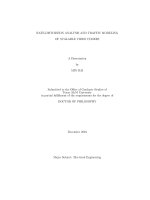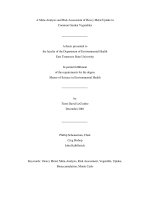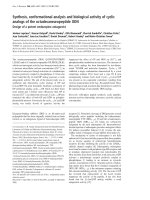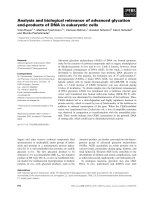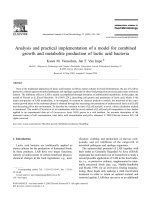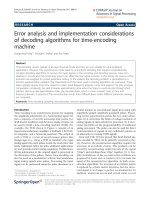The IAS 8 Analysis and Critical Thesis of the IAS 8
Bạn đang xem bản rút gọn của tài liệu. Xem và tải ngay bản đầy đủ của tài liệu tại đây (92.52 KB, 19 trang )
European Research Studies
Volume VIII, Issue (1-2), 2005
The IAS 8 Analysis and
Critical Thesis of the IAS 8
by Michail G. Bekiaris, Ph.D.
Internal Auditor, Alpha Bank
Audit and Inspection Division
Abstract
In this paper the concept and the solutions suggested by IAS 8 are analysed extensively by using accounting examples. These solutions are indicated in order to achieve a equable treatment of the issues that this standard
introduces in accounting.
In the first part the definitions of the Standard are presented and the
meanings of net profit or loss are clarified. Net profit or loss comes either
from enterprise’s ordinary activities or from activities of extraordinary nature the result of whom forms extraordinary results.
Afterwards, the accounting errors are mentioned and the way to correct
them is indicated using recent accounting examples. Moreover, in this paper
are mentioned the notifications that must be made in order to ensure the reliability of the economic conditions.
Finally, the accounting treatment of the changes in accounting policies is
made clear. These changes are described explicitly by using examples of
economic conditions.
International Accounting Standard IAS 8
1.
Net profit or loss for the period, fundamental errors and changes
in accounting policies.
1.1. Application
The Standard 8 is applied:
a) in presenting profit or loss from ordinary activities, in the Income
Statement.
b) in presenting profit or loss from extraordinary activities, in the Income Statement.
c) in accounting for changes in accounting estimates
Asymmetrical economic & institutional changes in the Western Balkans
3
d) in accounting for fundamental errors
e) in accounting for changes in accounting policies
The Standard 8 is also applied:
a) with the disclosure of certain items of net profit or loss for the period. These disclosures are made in addition to any other disclosures
required by other International Accounting Standards, including International Accounting Standards 5 “Information to be disclosed in
Financial Statement”.
b) with certain disclosures relating to discontinued operations.
1.2. Terms
The following terms are used in Standard 8 with the meanings specified:
Extraordinary items are income or expenses that arise from events or
transactions that are clearly distinct from the ordinary activities of the enterprise and therefore are not expected to recur frequently or regularly.
Ordinary activities are any activities, which are undertaken by an enterprise as part of its business, and such related activities in which the enterprise
engages in furtherance of, incidental to, or arising from these activities.
A discontinued operation results from the sale or abandonment of an
operation of an operation that represents a separate, major line of business of
an enterprise and of which the assets, net profit or less and activities can be
distinguished physically, operationally and for financial reporting purposes.
Fundamental errors are errors discovered in the current period that are
of such significance that the financial statements of one or more prior periods
can no longer be considered to have been reliable at the date of their issue.
Accounting policies are the specific principles, bases, conventions, rules
and practices adopted by an enterprise in preparing and presenting financial
statements.
1.3. Net profit or loss for the period
Normally all items of income and expense recognised in a period are included in the determination of the net profit or loss for the period. However,
circumstances may exist when certain items may be excluded from net profit
or loss for the current period, such as the correction of fundamental errors
and the effect of changes in accounting policies.
The net profit or loss for the period comprises the following components,
each of which should be disclosed on the face of the income statement:
a) profit or loss from ordinary activities
b) extraordinary items
4
European Research Studies, Volume VIII, Issue (1-2), 2005
1.3.1. Profit or loss from ordinary activities
Concept
Profit or loss from ordinary activities, is the profit or loss that results by
an enterprise as part of its business. When items of income and expense
within profit or loss from ordinary activities are of such size, nature or incidence that their disclosure is relevant to explain the performance of the enterprise for the period, it is necessary the nature and amount of such items to
be disclosed in the extract from notes to the financial statement.
The disclosure may be relevant to users of financial statements in understanding the financial position and performance of an enterprise and in making projections about financial position and performance.
Disclosure
Circumstances, which may give rise to the separate disclosure of items of
income and expense, include:
a) the write-down of inventories to net realisable value or property,
plant and equipment to recoverable amount, as well as the reversal
of such write-downs;
b) a restructuring of the activities of an enterprise and the reversal of
any provisions for the costs of restructuring
c) disposals of items of property, plant and equipment
d) disposals of long-term investments
e) discontinued operations
f) litigation settlements and
g) other reversals of provisions
1.3.2. Extraordinary items
Extraordinary items are income or expenses that arise from events or
transactions that are clearly distinct from the ordinary activities of the enterprise and therefore are not expected to recur frequently or regularly.
Whether an event or transaction is clearly distinct from the ordinary activities of the enterprise is determined by the nature of the event or transaction in relation to the business ordinarily carried on by the enterprise rather
than by the frequency with which such events are expected to occur. Therefore, an event or transaction may be extraordinary for one enterprise but not
extraordinary for another, because of the differences between their respective
ordinary activities. For example, losses sustained as a result of an earthquake
may qualify as an extraordinary item for many enterprises. However, claims
from policyholders arising from an earthquake do not qualify as an extraordinary item for an insurance enterprise that insurer against such risks.
Examples of events or transactions that generally give rise to extraordinary items for most enterprises are:
a) The expropriation of assets
b) An earthquake or other natural disaster
Asymmetrical economic & institutional changes in the Western Balkans
5
Disclosure
The disclosure of the nature and amount of each extraordinary item may
be made on the face of the income statement, or when this disclosure is made
in the notes to the financial statements, the total amount of all extraordinary
item is disclosed on the face of the income statement.
1.4. Discontinued operations
The following disclosures should be made for each discontinued operation, as defined in this Standard:
a) The nature of the discontinued operation
b) The industry and geographical segments in which it is reported in
accordance with IAS 14, Reporting Financial Information by Segment
c) The effective date of discontinuance for accounting purposes
d) The manner of discontinuance (sale or abandonment)
e) The gain or loss on discontinuance and the accounting policy used to
measure that gain or loss and
f) The revenue and profit or loss from the ordinary activities of the operation for the period, together with the corresponding amounts for
each prior period presented.
The results of a discontinued operation are generally included in profit or
loss from ordinary activities. However, in the rare circumstances that the discontinuance is the result of events or transactions that are clearly distinct
from the ordinary activities of the enterprise and therefore are not expected to
recur frequently or regularly, the income or expenses that arise from the discontinuance are treated as extraordinary items. For example, if a foreign
government expropriates a subsidiary, the income or expense that arise from
the expropriation may qualify as an extraordinary item.
When it is known at the date on which the financial statements are
authorised for issue that an operation was discontinued after the balance
sheet date or that will be discontinued.
In earlier versions, paragraph 1.4 has been replaced by IAS 35 “Discontinued Operations”.
1.5. Changes in accounting estimates
1.5.1. Concept
As a result of the uncertainties inherent in business activities, many financial statement items cannot be measured with precision but can only be
estimated. The estimation process involves judgements based on the latest
information available. Estimates may be required, for example, of bad debts,
6
European Research Studies, Volume VIII, Issue (1-2), 2005
inventory obsolescence or the useful lives or expected pattern of consumption of economic benefits of depreciable assets.
An estimate may have to be revised if changes occur regarding the circumstances on which the estimate was based or as a result of new information, more experience or subsequent developments. By its nature the revision
of the estimate does not bring the adjustment within the definitions of an extraordinary item or a fundamental error.
Sometimes it is difficult to distinguish between a change in accounting
policy and a change in an accounting estimate. In such cases, the change is
treated as a change in an accounting estimate, with appropriate disclosure.
1.5.2. Entry of a change in an accounting estimate
The effect of a change in an accounting estimate should be included in
the determination of net profit or loss in:
a) The period of the change, if the changes affects the period only. Example: a change in the estimate of the amount of bad debts affects
only the current period and therefore is recognised immediately.
b) The period of the change and future periods, if the changes affects
both. Example: a change in the estimated useful life or the expected
pattern of consumption of economic benefits of a depreciable asset
affects the depreciation expense in the current period and in each period during the remaining useful life of the asset. The effect, if any,
on future periods is recognised in future periods.
The effect of a change in an accounting estimate should be included in
the same income statement classification as was used previously for the estimate, in order to ensure the comparability of financial statements of different periods.
For example, the effect of a change in an accounting estimate for estimates which were previously included in the profit or loss from ordinary activities is included in that component of net profit or loss.
Disclosure
The nature and amount of a change in an accounting estimate that has a
material effect in the current period or which is expected to have a material
effect in subsequent periods should be disclosed. If it is impracticable to
quantify the amount, this fact should be disclosed.
1.6. Fundamental errors
Errors in the preparation of the financial statements of one or more prior
periods may be discovered in the current period.
Errors may occur as a result of mathematical mistakes, mistakes in applying accounting policies, misinterpretation of facts, fraud or oversights etc.
Asymmetrical economic & institutional changes in the Western Balkans
7
The correction of these errors is normally included in the determination
of net profit or loss for the current period.
We consider as fundamental errors those errors that has significant effect
on the financial statements of one or more prior periods that those financial
statements can no longer be considered to have been reliable at the date of
their issue.
An example of a fundamental error is the inclusion in the financial
statements of a previous period of material amounts of work in progress and
receivables in respect of fraudulent contracts, which cannot be enforced.
The correction of fundamental errors that relate to prior periods requires
the restatement of the comparative information or the presentation of additional pro forma information.
1.6.1. Correction of fundamental errors
For the correction of fundamental errors we use two treatments
a) benchmark treatment
b) alternative treatment
1.6.1.1. Benchmark Treatment
The amount of the correction of a fundamental error that relates to prior
periods should be reported by adjusting the opening balance of retained earnings. Comparative information should be restated, unless it is impracticable
to do so.
An enterprise using the benchmark treatment should:
a) The financial statements, including the comparative information for
prior periods, are presented as if the fundamental error had been corrected in the period in which it was made.
b) The amount of the correction that relates to each period presented is
included within the net profit or loss for that period.
c) The amount of the correction that relates to periods prior to those included in the comparative information in the financial statements is
adjusted against the opening balance of retained earnings in the earliest period presented.
Obligation for restatement of comparative information
The restatement of comparative information does not necessarily give
rise to the amendment of financial statements that have been approved by
shareholders or registered or filed with regulatory authorities. However, national laws may require the amendment of such financial statements.
Disclosure:
An enterprise should disclose the following:
a) the nature of the fundamental error
b) the amount of the correction for the current period and for each prior
period presented
8
European Research Studies, Volume VIII, Issue (1-2), 2005
c) the amount of the correction relating to periods prior to those included in the comparative information and
d) the fact that comparative information has been restated or that it is
impracticable to do so.
Example
During 2000, enterprise “A” discovered that certain products that had
been sold during 1999 were incorrectly included in inventory at 31 December 1999 at 6.500.
The report of the income statement and the statement of retained earnings on 31 December 1999, was the following:
Income Statement
2000
1999
Sales
104.000
73.500
Cost of goods sold
(86.500)
(53.500)
Profit from ordinary activities before income
taxes
17.500
20.000
Income taxes
(5.250)
(6.000)
Net profit
12.250
14.000
Statement of Retained Earnings
2000
1999
Opening retained earnings as previously reported
34.000
20.000
Net profit
12.250
14.000
Closing retained earnings 31.12.99
21.750
34.000
“A” income tax rate was 30% for 1999 and 2000
Correction of the fundamental error in the period 2000 and restatement
of the comparative information (period 1999).
Asymmetrical economic & institutional changes in the Western Balkans
9
After the correction of the fundamental error, this is the report of the income statement and the statement of retained earnings
Income Statement
2000
1999
Sales
104.000
73.500
Cost of goods sold
(80.000)
(60.000)
Profit from ordinary activities before income taxes
24.000
13.500
Income taxes
(7.200)
(4.050)
Net profit
16.800
9.450
Statement of Retained Earnings
2000
1999
Opening retained earnings as previously
reported
34.000
20.000
Correction of fundamental error (net of income taxes of 1,950) (note 1)
(4.550)
Opening retained earnings as restated
29.450
20.000
Net profit
16.800
9.450
Closing retained earnings
46.250
29.450
Extract from notes to the Financial Statement
Certain products that had been sold in 1999 were incorrectly included in
inventory at 31.12.1999 at 6.500. The financial statements of 1999 have been
restated to correct this error.
Notes
Income Statement
1) The cost of goods sold in 1999 has been increased by 6.500, while
the cost of goods sold in 2000 has been decreased by 6.500. Products
that had been sold in 1999 were not included in the cost of the goods
sold, but were incorrectly included at the inventory in 1999, thus the
income statement in 1999 was increased by this amount.
2) Income taxes in 1999 were decreased at 1.950 (6.500*30%). Correspondingly, income taxes in 2000 were increased.
10
European Research Studies, Volume VIII, Issue (1-2), 2005
Statement of Retained Earnings
1) The corrected amount of the fundamental error, net of income taxes,
appears complimentary at the opening retained earnings in 2000
(6.500*30%=1.950, 6.500 – 1.950 = 4.550). Thus, the correction of
the fundamental error in 1999 is included at the closing retained
earnings in 2000.
2) Note 1 refers to the ‘Extract from notes to the Financial Statements’.
1.6.1.2. Allowed alternative treatment
The amount of the correction of a fundamental error should be included
in the determination of net profit or loss for the current period. Comparative
information should be presented as reported in the financial statements of the
prior period. Additional pro forma information, according to the main
method, should be presented unless it is impracticable to do so.
The correction of a fundamental error is included in the determination of
net profit or loss for the current period. However, additional information is
presented, often as separate columns, to show the net profit or loss of the
current period and any prior periods presented as if the fundamental error had
been corrected in the period when it was made. It may be necessary to apply
this accounting treatment in countries where the financial statements are required to include comparative information, which agrees with financial
statements presented in prior periods.
Disclosure
An enterprise should disclose the following:
a. the nature of the fundamental error;
b. the amount of the correction recognised in net profit or loss for the
current period; and
c. the amount of the correction included in each period for which pro
forma information is presented and the amount of the correction relating to periods prior to those included in the pro forma information. If it is impracticable to present pro forma information, this fact
should be disclosed.
Example
During 2000, “A” discovered that certain products that had been sold
during 1999 were incorrectly included in inventory 31.12.1999 at 6.500.
The Income Statement and the Statement of Retained Earnings, in 1999
and 2000 were:
Asymmetrical economic & institutional changes in the Western Balkans 11
Income Statement
2000
1999
Sales
104.000
73.500
Cost of goods sold
(86.500)
(53.500)
Profit from ordinary activities before income
taxes
17.500
20.000
Income taxes
(5.250)
(6.000)
Net profit
12.250
14.000
Statement of Retained Earnings
2000
1999
Opening retained earnings as previously reported
34.000
20.000
Net profit
12.250
14.000
Closing retained earnings 31.12.99
21.750
34.000
“A” income tax rate for the years 1999 & 2000 was 30%.
After the correction of the fundamental error, Income Statement and
Statement of Retained Earnings are the followings:
Income Statement
Pro – forma
2000
1999
2000
1999
Sales
104.000
73.500
104.000
73.500
Cost of goods sold
(86.500)
(53.500)
(80.000)
(60.000)
Profit from ordinary activities before income taxes
17.500
20.000
24.000
13.500
Income taxes
(5.250)
(6.000)
(7.200)
(4.050)
Net profit
12.250
14.000
16.800
9.450
12
European Research Studies, Volume VIII, Issue (1-2), 2005
Statement of Retained Earnings
Opening retained earnings
as previously reported
2000
1999
2000
1999
34.000
20.000
34.000
20.000
Correction of fundamental
error (net of income taxes
1.950) (note 1)
(4.550)
Opening retained earnings
as restated
34.000
20.000
29.450
20.000
Net profit
12.250
14.000
16.800
9.450
Closing retained earnings
46.250
34.000
46.250
29.450
Extract from Notes to the Financial Statements
Cost of goods sold for 2000 includes 6.500 for certain products that had
been sold in 1999, but were incorrectly included in inventory at 31.12.1999.
Restated pro forma information in 2000 and 1999 is presented as if the error
had been corrected in 1999.
Notes
1) No change is recorded in the Financial Statements. The fundamental
error is corrected in the current period.
2) A restated pro forma is mentioned with the benchmark treatment, if
this is possible.
3) Note 1 refers to the “Notes to the Financial Statements”, which includes further explanation.
1.7. Changes in accounting policies
1.7.1. Accounting policies
Users need to be able to compare the financial statements of an enterprise
over a period of time to identify trends in its financial position, performance
and cash flows. Therefore, the same accounting policies are normally
adopted in each period.
A change in accounting policy should be made only:
a) if required by statute, or by an accounting standard setting body, or
b) if the change will result in a more appropriate presentation of events
or transactions in the financial statements of the enterprise.
A more appropriate presentation of events or transaction sin the financial
statements occurs when the new accounting policy results in more relevant or
Asymmetrical economic & institutional changes in the Western Balkans 13
reliable information about the financial position, performance or cash flows
of the enterprise.
1.7.2. Application of changes in Accounting policies
A change in accounting policy is applied retrospectively or prospectively
in accordance with the requirements of this Standard.
Retrospective application results in the new accounting policy being applied to events and transactions as if the new accounting policy had always
been in use. Therefore, the accounting policy is applied to events and transactions from the date of origin of such items.
Prospective application means that the new accounting policy is applied
to the events and transactions occurring after the date of change. No adjustments relating to prior periods are made either to the opening balance of retained earnings or in reporting the net profit or loss for the current period
because existing balances are not recalculated. However, the new accounting
policy is applied to existing balances as from the date of change.
Fore example, an enterprise may decide to change its accounting policy
for borrowing costs and capitalise those costs in conformity with the allowed
alternative treatment in International Accounting Standard IAS 23, “Borrowing Costs”. Under prospective application, the new policy only applies to
borrowing costs that are incurred after the date of the change in accounting
policy.
1.7.3. Cases that are not changes in accounting policies:
The following are not changes in accounting policies:
a. adoption of an accounting policy for events or transaction that differ
in substance from previously occurring events or transactions; and
b. the adoption of a new accounting policy for events or transactions
which did not occur previously or that were immaterial.
c. The initial adoption of a policy to carry assets at revalued amounts is
a change in accounting policy but it is dealt with as a revaluation in
accordance with International Accounting Standard IAS 16, “Property, Plant or Equipment’, or IAS 25, “Accounting for Investments”
as appropriate, rather than Standard 8.
1.7.4. Adoption of an International Accounting Standard
A change in accounting policy which is made on the adoption of an International Accounting Standard should be accounted for in accordance with
the specific transitional provisions, if any, in that International Accounting
Standard. In the absence of any transitional provisions, the change in accounting policy should be applied in accordance with the benchmark treatment or the allowed alternative treatment, of this Standard.
The transitional provisions in an International Accounting Standard may
require either a retrospective or a prospective application change in accounting policy.
14
European Research Studies, Volume VIII, Issue (1-2), 2005
When an enterprise has not adopted a new International Accounting
Standard which has been published by the International Accounting Standards Committee but which has not yet come into effect, the enterprise is
discouraged to disclose the nature of the future change in accounting policy
and an estimate of the effect of the changes on its net profit or loss and financial position.
1.7.5. Other Changes in Accounting Policies
A change in accounting policy has two treatments
a) The benchmark treatment
b) The allowed alternative treatment.
1.7.5.1. Benchmark Treatment
a) a change in accounting policy should be applied retrospectively
unless the amount of any resulting adjustment that relates to prior
periods is not reasonably determinable.
b) any resulting adjustments should be reported as an adjustment to the
opening balance of retained earnings.
c) comparative information should be restated unless it is impracticable
to do so.
The financial statements, including the comparative information for prior
periods, are presented as if the new accounting policy had always been in
use. Therefore, comparative information is restated in order to reflect the
new accounting policy. The amount of the adjustment relating to periods
prior to those included in the financial statements is adjusted against the
opening balance of retained earnings of the earliest period presented. Any
other information with respect to prior periods, such as historical summaries
of financial data, is also restated.
The restatement of comparative information does not necessarily give
rise to the amendment of financial statements which have been approved by
shareholders or registered or filed with regulatory authorities. However, national laws may require the amendment of such financial statements.
The changes in accounting policy should be applied prospectively when
the amount of adjustment to the opening balance of retained earnings cannot
be reasonably determined.
Disclosure
When a change in accounting policy has a material effect on the current
period or any prior period presented, or may have a material effect in subsequent periods, an enterprise should disclose the following:
a. the reasons for the change;
b. the amount of the adjustment for the current period and for each period presented;
c. the amount of the adjustment relating to periods prior to those included in the comparative information; and
Asymmetrical economic & institutional changes in the Western Balkans 15
d.
the fact that comparative information has been restated or that it is
impracticable to do so.
Example
During 1992, “A” changed its accounting policy with respect to the
treatment of borrowing costs that are directly attributable to the acquisition
of a hydro-electric power station which is in course of construction.
In previous periods, “A” has capitalised such costs, net of incomes taxes,
in accordance with the allowed alternative treatment in IAS 23, Borrowing
Costs. “A” has now decided to expense, rather than capitalise, these costs in
order to conform with the benchmark treatment in IAS 23.
“A” capitalised borrowing costs incurred of 2,600 during 1991 and 5,200
in periods prior to 19X1. All borrowing costs incurred in previous years in
respect to the acquisition of the power station were capitalised.
“A” has not yet recognised any depreciation on the power station because it is not in use.
Income tax rate was 30% for 1991 and 1992.
In 1991, “A” reported:
Extract from the Income Statement
Profit from ordinary activities before interest and income taxes
Interest expense
Profit from ordinary activities before income taxes
Income taxes
Net profit
Statement of Retained Earnings
Opening retained earnings
Net profit 1991
Closing retained earnings 1991
18.000
18.000
(5.400)
12.600
20.000
12.600
32.600
Extract from the Income Statement
1992
1991
Profit from ordinary activities before interest and income taxes
30.000
18.000
Interest expenses
(3.000)
(2.600)
Profit from ordinary activities before income taxes
27.000
15.400
Income taxes
(8.100)
(4.620)
Net profit
18.900
10.780
16
European Research Studies, Volume VIII, Issue (1-2), 2005
Statement of Retained Earnings
1992
1991
Opening retained earnings as previously reported
32.600
20.000
Change in accounting policy with respect to the capitalisation of interest (net income taxes of 2.340 for
1992 and 1560 for 1991)
(5.460)
(3.640)
Opening retained earnings as restated
27.140
16.360
Net profit
18.900
10.780
Closing retained earnings
46.040
27.140
Notes
1) In the 1991 Income Statement, income tax was decreased at 4.620
(5.400 – 780). Due to the change in the accounting policies, interest
expenses were not capitalised, but instead were posted in the income
statement with the effect that taxable income and income tax were
decreased accordingly.
2) Due to the change in the accounting policies, interest expenses after
taxes in 1991 reduced the opening retain earnings by 3.640. These expenses, that concern periods before 1991 had already been capitalised.
According to the benchmark treatment the amount of the correction
that relates to periods prior to those included in the financial statements is adjusted against the opening balance of retained earnings in
the earliest period presented.
The formula is: 5.200 X 30% = 1.560, 5.200 –1.560 = 3.640.
3) Using the same method as described in paragraph 2, the adjusting
entry for the 1992 period reduces the opening balance by 5.460.
The calculation is 5.200 + 2.600 = 7.800 X 30% + 2.340, 7.800 –
2.340 = 5.460.
4) After the above mentioned adjusting entries the opening retained
earnings in 1992 will be the same with the closing retained earnings
in 1991, and the Income Statement will be restated.
5) Note 1 refers to the extract from the ‘Notes to the Financial Statements’.
Extracts from notes to the Financial Statements
During 1992, "A” changes its accounting policy with respect to the
treatment of borrowing costs related to a hydro-electric power station which
is in course of construction for use by "A” . In order to conform with the
benchmark treatment in IAS 23, Borrowing Costs, the enterprise now expenses rather than capitalises such costs. This change in accounting policy
has been accounted for retrospectively. The comparative statements for 1991
Asymmetrical economic & institutional changes in the Western Balkans 17
have been restated to conform to the changed policy. The effect of the
change is an increase in interest expense of 3,000 (1992) and 2,600 (1991).
Opening retained earnings for 1991 have been reduced by 5,200 which is the
amount of the adjustment relating to periods prior to 1991.
1.7.5.2. Allowed Alternative Treatment
a) A change in accounting policy should be applied retrospectively
unless the amount of any resulting adjustment that relates to prior
periods is not reasonably determinable.
b) Any resulting adjustment should be included in the determination of
profit or loss for the current period.
c) Comparative information should be presented as reported in financial statements of the prior period.
d) Additional pro forma comparative should be presented unless it is
impracticable to do so.
Adjustments resulting from a change in accounting policy are included in the
determination of the net profit or loss for the period. However, additional comparative information is presented, often as separate columns, in order to show the
net profit or loss and the financial position of the current period and any prior
periods presented as if the new accounting policy had always been applied.
It may be necessary to apply this accounting treatment in countries where
the financial statements are required to include comparative information
which agrees with the financial statements presented in prior periods.
The change in accounting policy should be applied prospectively when
the amount to be included in net profit or loss for the current period cannot
be reasonably determined.
Disclosure
When a change in accounting policy has a material effect on the current
period or any prior period presented, or may have a material effect in subsequent periods, an enterprise should disclose the following:
a. the reasons for the change;
b. the amount of the adjustment recognised in net profit or loss in the
current period; and
c. the amount of the adjustment included in each period for which pro
forma information is presented and the amount of the adjustment relating to periods prior to those included in the financial statements. If
it is impracticable to present pro forma information, this fact should
be disclosed.
Example
During 1992, "A” changes its accounting policy with respect to the
treatment of borrowing costs related to a hydro-electric power station which
is in course of construction for use by "A”.
18
European Research Studies, Volume VIII, Issue (1-2), 2005
In previous periods, “A” has capitalised such costs, net of incomes taxes,
in accordance with the allowed alternative treatment in IAS 23, Borrowing
Costs. “A” has now decided to expense, rather than capitalise, these costs in
order to conform with the benchmark treatment in IAS 23.
“A” capitalised borrowing costs incurred of 2,600 during 1991 and 5,200
in periods prior to 1991. All borrowing costs incurred in previous years in
respect to the acquisition of the power station were capitalised.
“A” has not yet recognised any depreciation on the power station because it is not in use.
Income tax rate was 30% for 1991 and 1992.
Profit from ordinary activities before interest and income taxes
Interest expenses
Profit from ordinary activities before income taxes
Income taxes
Net profit
18.000
18.000
(5.400)
12.600
Opening retained earnings
Net profit
Closing retained earnings
20.000
12.600
32.600
In 1992 “A”, after the changes in accounting policies, reported
Extract from the Income Statement
Restated
1992
1991
1992
1991
Profit from ordinary activities before interest and income taxes
30.000
18.000
30.000
18.000
Income expenses
(3.000)
(3.000)
(2.600)
Cumulative effect of change in accounting policy
(7.800)
-
-
-
Profit from ordinary activities before income taxes
19.200
18.000
27.000
15.400
Income taxes
(5.760)
(5.400)
8.100
4.620
Net profit
13.440
12.600
18.900
10.780
Asymmetrical economic & institutional changes in the Western Balkans 19
Statement of Retained Earnings
Restated
Opening retained earnings as previously reported
1992
1991
1992
1991
32.600
20.000
32.600
20.000
(5.460)
(3.640)
Changes in accounting policy with
respect to the capitalisation of interest (net of income taxes of 2.340
for 1992 and 1.560 for 1991) (note
1)
Opening retained earnings as restated
32.600
20.000
27.140
16.360
Net profit
13.440
12.600
18.900
10.780
Closing retained earnings
46.040
32.600
46.040
27.140
Notes
1) As we understand from the above example does not befall change in
the report of financial statements, profit or loss that resulted from the
changes in the accounting policies it is corrected in the current period.
2) In the Income Statement 7.800, concerns accumulated result of
change in accounting policies, which includes the interest expenses
in 1991 and prior periods (2.600 + 5.200), corrects the opening retained earnings in 1991.
3) Is mentioned informal restated who has been worked out according
to the benchmark treatment, provided that it is possible to be worked
out.
4) Note 1 is reported the extracts from notes to the Financial Statements, where exists relative explanation.
Extracts from notes to the Financial Statements (Note 1)
1. An adjustment of 7,800 has been made in the income statement for
1992 representing the effect of a change in accounting policy with respect to
the treatment of borrowing costs related to a hydro-electric power station
which is in course of construction for use by “A”. In order to conform with
the benchmark treatment in IAS 23, Borrowing Costs, the enterprise now
expenses rather than capitalise such costs.
2. This change in accounting policy has been accounted for retrospectively. Restated pro forma information, which assumes that the new policy
had always been in use, is presented. Opening retained earnings in the pro-
20
European Research Studies, Volume VIII, Issue (1-2), 2005
forma information for 1991 have been reduced by 5,200 which is the amount
of the adjustment relating to periods prior to 1991.
1.8. Conclusion
In this paper, an effort was made to present clearly the implicit meaning
of the definitions, stipulated in IAS 8, using specific examples, in an effort to
help accountants further in their understanding.
This is deemed necessary because no clear definition of extraordinary result is available, in the international practice. Certain items are described as
extraordinary but only under specific circumstances.
It is our hope that this paper will help towards a better understanding of
the concepts of IAS 8, given the importance that the users of accounting information attach in determine the fairness of the accounting result.
References
Arne Kinserdal Financial Accounting An International Perspective, 2nd Edition, Pitman Publishing, 1998.
Choi, Frederick D.S., Frost Carol Ann, Meek Gary K., International Accounting, 3rd Edition, Pitman Publishing, 1997, ISBN: 0-13-0114014.
Clare Roberts, Pauline Weetman, Gordon P., International Financial Accounting, Pitman Publishing, 1998.
Davis Mike, Paterson Ron and Wilson Allister, Uk Gaap, 5th Edition, Pitman
Publishng, ISBN: 0-333-64260-0.
IASC, Annual Review International Accounting Standards Commite, Annual
Review, 1997.
Kam Vernon, Accounting Theory, 5th Edition, WILEY Publishing, 1997,
ISBN: 0-471-50704-0.
Leo G. Van Der Tas Measuring Harmonisation of Financial Reporting Practice Accounting and Business Research Volume 18, 1998.
Nobes Christopher, Parker Robert, Comparative International Accounting,
6th Edition, Prentice Hall Publishing, 1997, ISBN: 0-13-328733-5.
Paul Reimond, Monique Hinard, Jurgen Weitkamp Comparing European
Companies European Management Journal Volume 6 1988.
Pauline Weetman and Sidney J. Gray A comperative International Analysis
of the Impact of Accounting Principles on Profits: The USA versus
UK, Sweden and Netherlands Accounting and Business Research
Volume 25 Number 98 Spring 1995.
